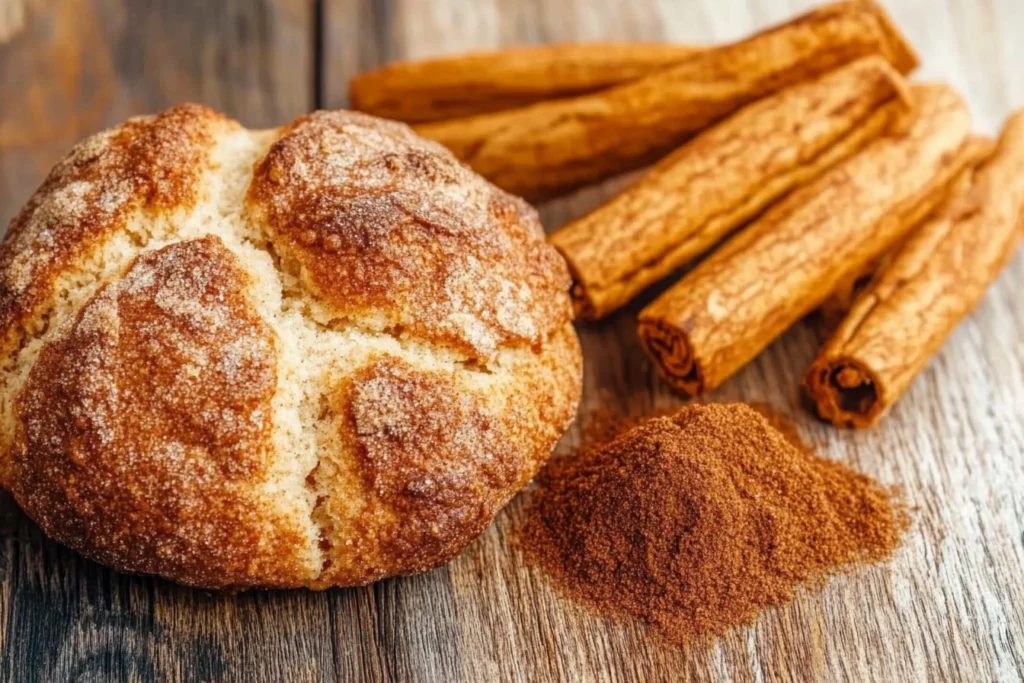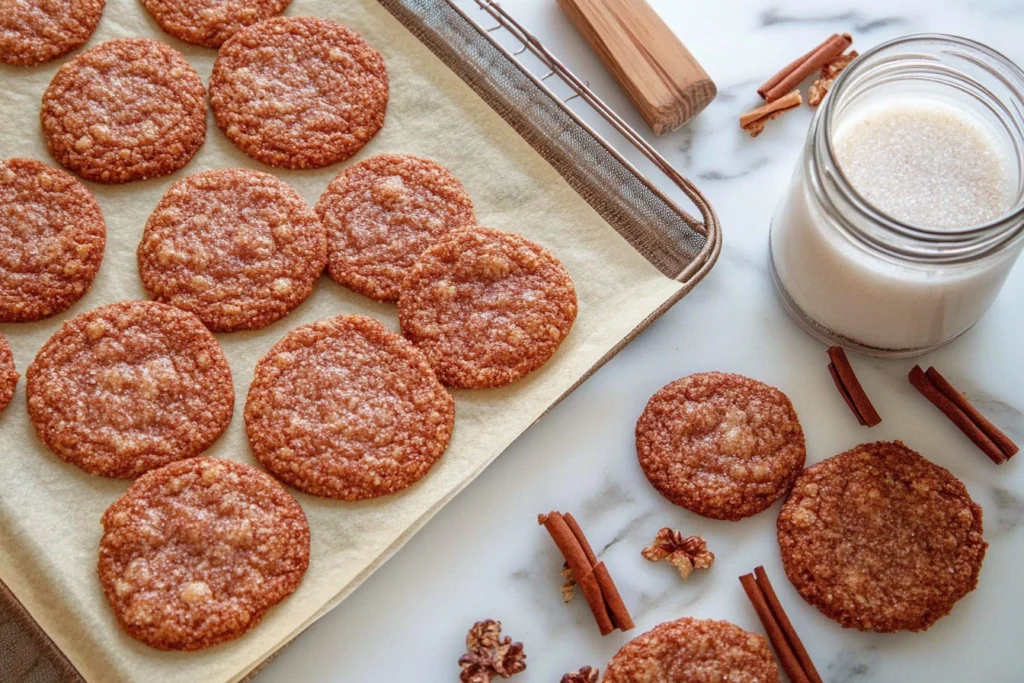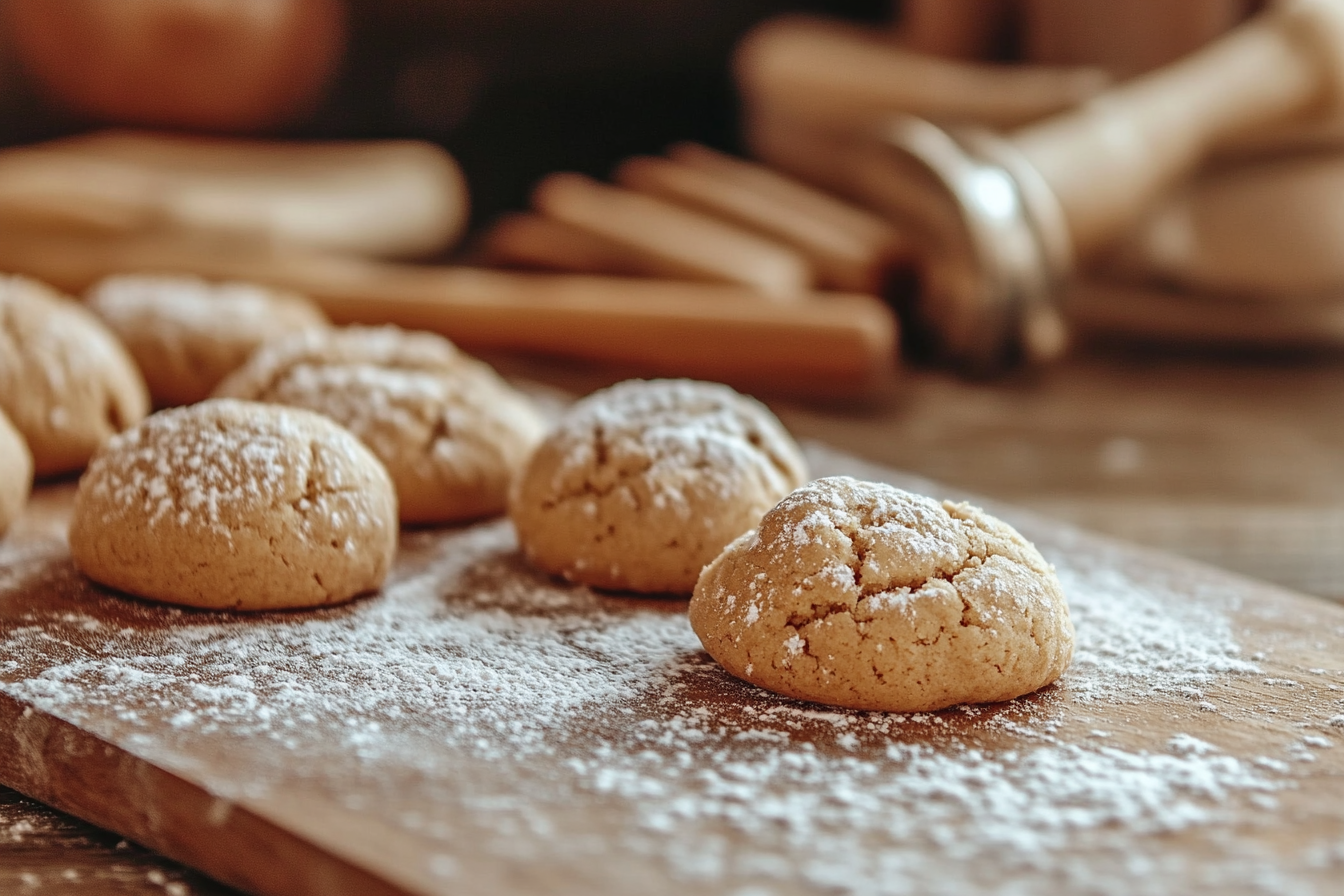H1: Introduction to Cream of Tartar in Baking
Cream of tartar is a staple in many classic baking recipes, known for its unique ability to enhance both flavor and texture. For snickerdoodles, this ingredient is a game-changer, providing the tangy taste and soft, chewy texture that makes them stand out from other cookies. But what exactly is cream of tartar, and why is it so essential in snickerdoodles?
Let’s uncover its chemistry and role in baking by exploring the Role of Cream of Tartar in Snickerdoodles. This acidic ingredient works by reacting with baking soda to create carbon dioxide, which helps the cookies rise and develop their characteristic light and chewy texture. Additionally, it prevents sugar from crystallizing, ensuring a softer bite instead of a crunchy or overly dense cookie. Without cream of tartar, snickerdoodles may lack their signature tang and ideal consistency, making it a key element in the traditional recipe.
H2: What is Cream of Tartar?
Cream of tartar, or potassium bitartrate, is a fine white powder derived as a byproduct of winemaking. Formed naturally in wine barrels during fermentation, it’s collected and purified for culinary use.
Key features:
- Acidity: Cream of tartar is a mild acid, making it versatile in baking and cooking.
- Stabilizer: It’s frequently used to stabilize whipped egg whites and prevent sugar crystallization in syrups.
- Leavening Agent: In recipes like snickerdoodles, it reacts with baking soda to create the perfect rise.
Understanding its chemical makeup is key to appreciating its importance in recipes.
H3: Chemical Composition of Cream of Tartar
Cream of tartar’s formula, KC₄H₅O₆, reveals its acidic properties, which are critical for balancing the alkaline baking soda in dough. This reaction:
- Produces carbon dioxide gas, causing the dough to rise.
- Adds a mild tanginess, enhancing flavor.
- Prevents sugar from crystallizing, resulting in a smoother texture.
Its chemical role in snickerdoodles is irreplaceable for achieving their iconic structure and taste.
H4: Role of Cream of Tartar in Baking Recipes
Cream of tartar isn’t just about flavor—it’s a multi-functional ingredient that performs key roles in baking:
- Leavening: Provides lightness by creating air pockets in dough.
- Stabilizing: Keeps ingredients, like egg whites, from deflating during mixing.
- Texture Control: Ensures smooth, tender baked goods.
In snickerdoodles, it specifically balances the dough’s chemistry, producing the perfect chewiness and preventing overly crispy results.

H5: Why Snickerdoodles Stand Out Among Cookies
Snickerdoodles are beloved for their buttery interior, cinnamon-sugar coating, and slight tang. Unlike traditional sugar cookies, snickerdoodles owe their distinct flavor to cream of tartar. It:
- Creates a unique tang that complements the cinnamon.
- Helps maintain a soft and tender bite.
- Prevents the cookies from tasting overly sweet.
This combination makes snickerdoodles a standout in the cookie world.
H6: The Historical Use of Cream of Tartar in Snickerdoodles
The history of snickerdoodles dates back to 19th-century Europe and America, where they gained popularity due to their simplicity and unique flavor. Cream of tartar became a key ingredient as baking science advanced, providing a reliable way to ensure consistency and rise in homemade cookies.
H2: Acidic Properties of Cream of Tartar
Cream of tartar’s acidity is its defining trait, influencing flavor, texture, and chemical reactions in dough. Its acidic properties work in tandem with other ingredients to create perfectly balanced cookies.
H3: Its Role in Activating Baking Soda
When combined with baking soda, cream of tartar acts as an acid to trigger a chemical reaction. This reaction:
- Produces bubbles of carbon dioxide, causing the dough to rise.
- Ensures the cookies puff up while baking, rather than spreading flat.
- Creates a light, airy texture inside the cookie.
Without cream of tartar, snickerdoodles might lack the lift needed for their signature look and feel.
H4: Preventing Sugar Crystallization in Dough
One of cream of tartar’s lesser-known functions is its ability to prevent sugar crystallization. In cookie dough:
- It ensures the sugar remains smooth and evenly distributed.
- This prevents gritty or crunchy textures in the final product.
- It contributes to the chewy consistency that defines snickerdoodles.
This property makes cream of tartar an essential component in achieving professional-quality cookies.
H5: Enhancing the Cookie’s Tangy Flavor
The tangy flavor of snickerdoodles comes directly from the acidity of cream of tartar. This subtle tartness:
- Balances the sweetness of the sugar.
- Enhances the spiciness of the cinnamon coating.
- Adds a layer of complexity to the overall flavor.
Without it, snickerdoodles would lose much of their unique taste, becoming more like standard sugar cookies.
Part 2: The Science Behind Cream of Tartar in Snickerdoodles
Part 2: The Science Behind Cream of Tartar in Snickerdoodles
H1: Texture and Structure Contributions
Cream of tartar plays a central role in shaping the texture and structure of snickerdoodles. Its ability to interact with other ingredients ensures that these cookies remain soft and tender, with a delicate balance between chewiness and fluffiness.
How it contributes:
- Leavening Power: By creating tiny air pockets in the dough, cream of tartar ensures a soft interior.
- Prevents Dryness: In addition, it balances the reaction with baking soda to retain moisture in the cookies.
- Fine Crumb Structure: Moreover, it ensures the cookies break apart smoothly without crumbling.
As a result of these scientific interactions, cream of tartar is the secret to the perfect snickerdoodle texture.
H2: Achieving Soft and Chewy Cookies
The hallmark of a great snickerdoodle is its soft, chewy texture. Fortunately, cream of tartar ensures this by performing several critical roles:
- Controlling Spread: It slows the breakdown of fats, ensuring the cookies hold their shape.
- Preventing Crystallization: Furthermore, it prevents sugar from crystallizing during baking, which could make the cookies crunchy.
- Moisture Retention: The acidity traps water molecules, preventing the cookies from drying out.
As a result, these factors combine to create cookies that are tender on the inside with a slightly crisp edge.
H3: How Cream of Tartar Impacts Dough Rise
When cream of tartar reacts with baking soda, it produces carbon dioxide gas, which causes the dough to puff up. This rise is essential for several reasons:
- Light, Airy Texture: It gives the cookies their classic softness.
- Avoiding Density: In addition, the reaction prevents cookies from becoming dense or flat.
- Even Baking: The process ensures a uniform texture across the entire batch.
Therefore, without cream of tartar, the rise may be insufficient, leading to uneven or overly dense cookies.
H4: Preventing Over-Spread in Snickerdoodles
Over-spread is a common issue when baking cookies. However, cream of tartar acts as a stabilizer, effectively preventing this by:
- Strengthening Dough Structure: It ensures the dough maintains its shape during baking.
- Controlling Fat Melting: Additionally, it regulates the melting point of fats to prevent excessive spreading.
- Ensuring Uniformity: This ensures a uniform shape and size across all cookies.
Thus, stabilization provided by cream of tartar helps snickerdoodles retain their signature round, puffy appearance.
H5: Influence on Final Cookie Texture
The final texture of snickerdoodles is a balance of chewiness, softness, and a slight crisp on the edges. Cream of tartar plays an essential role in this balance by:
- Creating a Tender Crumb: Its anti-crystallization properties keep the cookies smooth and chewy.
- Avoiding Excess Crunch: Furthermore, it regulates sugar behavior during baking, ensuring no hard or gritty spots.
- Enhancing Moistness: Lastly, it traps moisture, which avoids dry or brittle cookies.
Therefore, this ingredient is vital for achieving the ideal texture in snickerdoodles.
H6: Tangy Flavor Profile and Its Connection to Cream of Tartar
The tangy taste of snickerdoodles is one of their defining characteristics, and cream of tartar is the sole contributor to this flavor.
Its acidity provides:
- A Subtle Tartness: This balances the sweetness of sugar and richness of butter.
- Depth of Flavor: Moreover, it enhances the complexity of the cookie.
- Harmony with Cinnamon: Finally, the tang pairs perfectly with the spiced cinnamon-sugar coating.
Without cream of tartar, the tangy profile would be noticeably absent, ultimately altering the cookie’s signature flavor.
H2: Cream of Tartar as a Stabilizing Agent
Stabilization is an underappreciated but critical role of cream of tartar in baking. Not only does it ensure consistency, but it also prevents chemical breakdowns during the mixing and baking process.
H3: Controlling pH Levels in the Dough
Cream of tartar helps regulate the pH of cookie dough, which benefits the recipe in several ways:
- Promoting Chemical Reactions: It ensures the proper interaction between baking soda and acidic elements.
- Enhancing Flavor: Furthermore, it controls the taste profile by balancing sweetness and acidity.
- Improving Shelf Life: Lastly, the acidic environment can help preserve the freshness of baked cookies.
This makes cream of tartar indispensable for achieving consistent results.
H4: Preventing Ingredients from Breaking Down
When baking at high temperatures, some ingredients can degrade, leading to inconsistent results. Cream of tartar prevents this by:
- Stabilizing Egg Whites: For example, it helps whipped egg whites maintain their structure.
- Controlling Sugar Behavior: It prevents sugars from caramelizing too quickly, which can result in burnt flavors.
- Strengthening Dough: Lastly, it creates a more resilient dough that holds up during baking.
As a result, this ensures professional-quality results for each batch.
H5: Enhancing Consistency Across Batches
One of the greatest challenges in baking is achieving consistency across multiple batches. Fortunately, cream of tartar plays a crucial role in ensuring:
- Uniform Texture: Each cookie has the same softness and chewiness.
- Predictable Rise: All cookies rise evenly, avoiding some being flat while others puff up.
- Flavor Balance: The tanginess remains consistent, regardless of slight variations in other ingredients.
In conclusion, this reliability makes cream of tartar indispensable for producing high-quality snickerdoodles.
Final Thoughts on the Science of Cream of Tartar
The scientific role of cream of tartar in snickerdoodles is profound. From creating the perfect texture to enhancing flavor and consistency, it’s the backbone of this classic cookie recipe. Therefore, without it, snickerdoodles would lose their signature qualities. This highlights the importance of understanding and appreciating this small but mighty ingredient.sic cookie recipe. Without it, snickerdoodles would lose their signature qualities, highlighting the importance of understanding and appreciating this small but mighty ingredient.
Part 3: Exploring Alternatives and Variations
H1: Can Snickerdoodles Be Made Without Cream of Tartar?
Yes, snickerdoodles can be made without cream of tartar, but it requires thoughtful adjustments to maintain the signature tang and chewy texture. Cream of tartar is integral to the traditional recipe, so finding suitable substitutes is key to recreating the authentic flavor and structure.
Challenges of omitting cream of tartar:
- The cookies may lack their characteristic tangy flavor.
- Texture may shift from soft and chewy to crisp or dense.
- The rise and shape of the cookies might not match the traditional appearance.
Understanding these potential pitfalls helps bakers make informed adjustments for successful substitutions.

H2: Substituting Cream of Tartar: Challenges and Solutions
When substituting cream of tartar, bakers often face issues related to flavor, texture, and consistency. However, with the right substitutes, these challenges can be mitigated.
Common substitutes:
- Baking Powder: A convenient option as it contains both acid and base. Replace cream of tartar and baking soda with 1 1/2 teaspoons of baking powder per 1 teaspoon of cream of tartar.
- Lemon Juice or Vinegar: Adds acidity but requires liquid adjustments. Use 2 teaspoons of liquid for every teaspoon of cream of tartar.
- Citric Acid: A dry, flavor-neutral substitute. Use half the amount of cream of tartar required.
Each substitute comes with its unique benefits and challenges, which must be carefully managed for optimal results.
H3: Alternatives for Achieving the Classic Tang
The tangy flavor of snickerdoodles is a defining trait, and substitutes like lemon juice, vinegar, or citric acid can help replicate it. Here’s how they compare:
- Lemon Juice: Adds a citrusy tang, though it may alter the cookie’s flavor slightly.
- White Vinegar: Provides acidity without introducing additional flavors.
- Citric Acid: The closest match to cream of tartar, as it’s flavor-neutral and mimics acidity well.
Choosing the right substitute depends on the desired flavor and availability of ingredients.
H4: Textural Changes When Omitting Cream of Tartar
The absence of cream of tartar can significantly impact the cookie’s texture. Substitutes can address these issues, but some changes may still occur:
- Baking Powder: Maintains softness but reduces chewiness slightly.
- Lemon Juice or Vinegar: May increase spread if liquid adjustments aren’t made.
- Citric Acid: Preserves texture best due to its dry, concentrated nature.
Experimenting with small batches is the best way to evaluate textural outcomes.
H5: Balancing Flavors Without the Traditional Ingredient
Flavor balance is critical when omitting cream of tartar. To preserve the classic tangy and sweet harmony, consider these tips:
- Enhance Tanginess: Add a pinch of citric acid or increase the substitute’s quantity slightly.
- Control Sweetness: Reduce sugar slightly to balance rich or tangy substitutes like yogurt or buttermilk.
- Boost Cinnamon Flavor: Increase cinnamon in the coating to complement altered flavors from substitutes.
These adjustments ensure the cookies remain flavorful and well-balanced.
H6: Cream of Tartar in Modern vs. Traditional Recipes
In modern baking, cream of tartar remains a favorite for achieving consistent results. However, traditional recipes often relied on natural acids like buttermilk or vinegar to mimic its effects.
How they compare:
- Modern Recipes: Use cream of tartar for predictable, uniform results.
- Traditional Recipes: Achieved similar effects through creative use of natural acidic ingredients.
Both methods yield delicious results but reflect different approaches to baking science.
H2: Adjusting the Recipe for Preferences
Bakers often modify snickerdoodle recipes to suit dietary preferences or flavor profiles. These adjustments can also help when cream of tartar isn’t available.
Ideas for adjustments:
- Dietary Substitutions: Use plant-based yogurt or vegan buttermilk as acidic substitutes for cream of tartar.
- Flavor Variations: Experiment with spices like nutmeg or cardamom in addition to cinnamon for a unique twist.
- Healthier Options: Substitute part of the sugar with coconut sugar or use whole wheat flour for a more wholesome cookie.
These tweaks allow bakers to customize snickerdoodles without sacrificing their charm.
H3: Combining Substitutes for Optimal Results
Sometimes, combining substitutes can yield better results than relying on one. For example:
- Baking Powder + Lemon Juice: Adds tanginess while maintaining structure.
- Citric Acid + Vinegar: Provides acidity without affecting dough consistency.
- Yogurt + Baking Soda: Adds tang, moisture, and rise for a softer cookie.
Experimenting with combinations can help achieve the perfect balance of flavor and texture.
H4: Tips for Perfecting Snickerdoodles with or Without Cream of Tartar
Whether using cream of tartar or substitutes, the following tips ensure success:
- Chill the Dough: Chilling prevents over-spread and helps the cookies hold their shape.
- Measure Accurately: Precision is key, especially when using substitutes that alter the dough’s chemistry.
- Test Small Batches: Experiment with smaller quantities to refine substitute ratios and baking times.
- Focus on Coating: A well-balanced cinnamon-sugar coating enhances the cookie’s flavor profile.
These tips ensure consistently delicious snickerdoodles, regardless of ingredient adjustments.
H5: Conclusion: The Importance of Cream of Tartar in Snickerdoodles
Cream of tartar is more than just a leavening agent—it’s the heart of snickerdoodles. From creating their chewy texture to delivering their tangy flavor, it defines this classic cookie. While substitutes can replicate some qualities, nothing matches the simplicity and reliability of cream of tartar. Still, with creativity and careful adjustments, it’s possible to bake equally delightful snickerdoodles without it.
Short FAQs: Cream of Tartar in Snickerdoodles
- What if I skip cream of tartar?
Cookies lose tang, rise, and chewy texture. - Best substitute for cream of tartar?
Baking powder. - Can I use lemon juice?
Yes, 2 teaspoons for every 1 teaspoon of cream of tartar. - Does it affect flavor?
Yes, it adds tanginess. - Why pair with baking soda?
For leavening and texture. - Is citric acid a good substitute?
Yes, it mimics acidity without changing flavor. - Will texture change without it?
Yes, cookies may spread more and lose chewiness. - Can I use white vinegar?
Yes, replace in equal amounts. - Are vegan substitutes available?
Yes, try plant-based yogurt or buttermilk. - How to prevent spreading?
Chill dough and use stabilizing substitutes.

